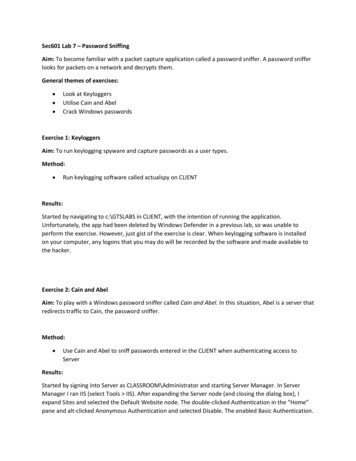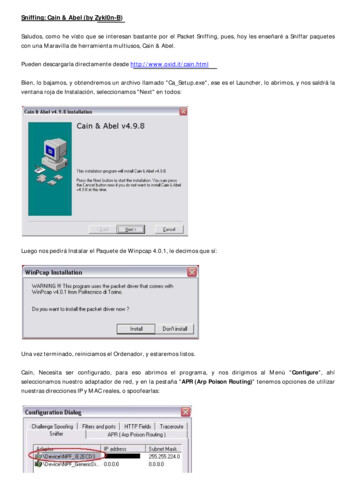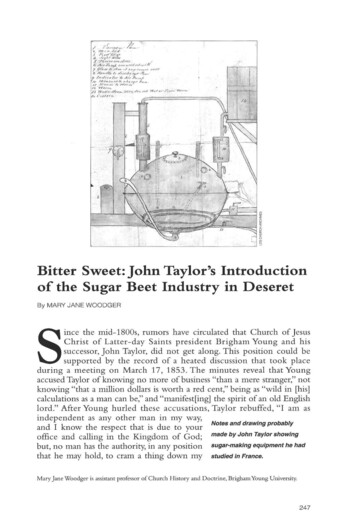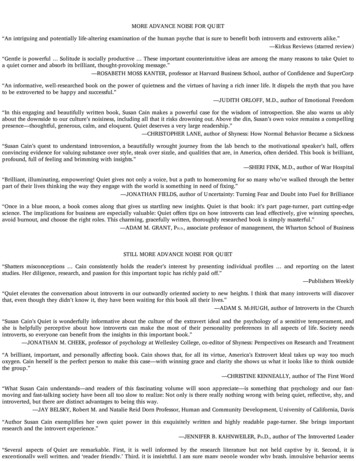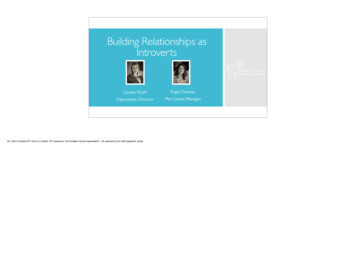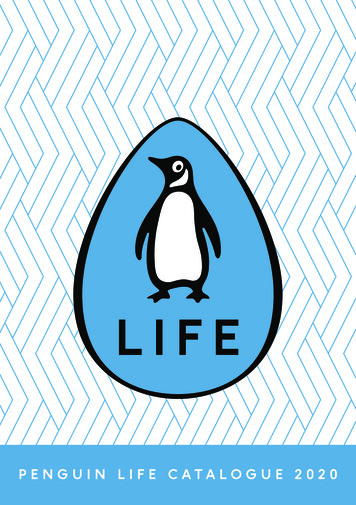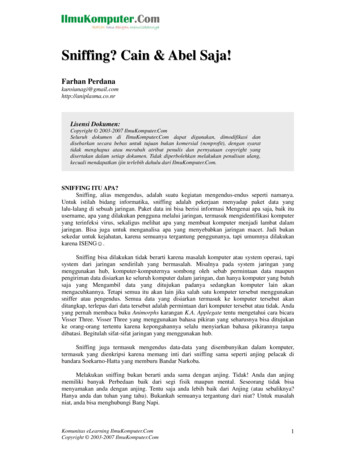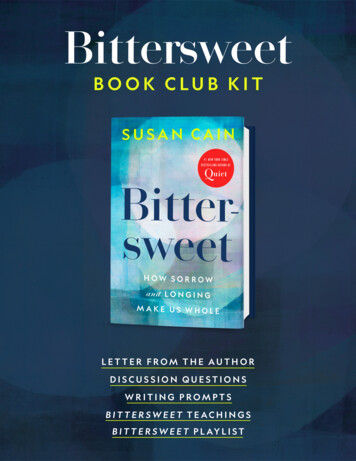
Transcription
BittersweetBOOK CLUB KITLETTER FROM THE AUTHORDISCUSSION QUESTIONSWRITING PROMPTSB I T T E R SW E E T T E AC H I N G SB I T T E R S W E E T P L AY L I S T
BittersweetDEAR READER,After a five-year labor of love—and ten years of overwhelming feedback from readers of Quiet—I’m thrilled to share my new book, Bittersweet: How Sorrow and Longing Make Us Whole. Thisbook, in a nutshell, is my answer to the question: What are the powers of a bittersweet, melancholic outlook—and why have we been so blind to its value?I’ve perceived these powers since I was very young, though it took me decades to name and understand them. Bittersweetness, as I see it, is a tendency to sorrow and longing; an acute awareness of passing time; and a piercing joy at the beauty of the world. It recognizes that light anddark, birth and death—bitter and sweet—are forever paired. And it’s the key to a full and satisfying life. If we realize that all humans know–or will know–sorrow and loss, as well as joy, we cantransform personal and collective pain into creativity, spirituality, and love.I hope this guide enhances your reading of the book, whether you’re reading on your own or in agroup with others. I’ve included some additional materials here, including my Top-40 BittersweetPlaylist, discussion questions, writing prompts, and more. And if you’d like something sweet,why not enjoy some bittersweet chocolate, sip some tea, or enjoy a glass of your favorite drinkwhile you read. I’d love to hear your thoughts, including any songs you may add to the ainSusanCainAuthorBITTERSWEET BY SUSAN CAIN
BittersweetDISCUSSION QUESTIONS1.What do you think of the Bittersweet idea that “light and dark, birth and death—bitter and sweet”—are foreverpaired? Does this describe your life experiences? What areas of your life do you now see through a “bittersweet” lens?2. How did you score on the “Bittersweet Quiz”? Do you tear up easily at touching TV commercials? Do you reactintensely to music, art, or nature? Have others described you as an “old soul”?3.“People play the happy songs on their playlists about 175 times on average, but they play the sad songs almost800 times,” writes Susan Cain: “They tell researchers that they associate sad music with profound beauty, deepconnection, transcendence, nostalgia, and common humanity.” Can you relate to this? What songs do you enjoylistening to? Which are your favorites and why?4. “Longing is momentum in disguise,” Susan Cain says, “it’s active, not passive; touched with the creative, thetender, and the divine. We long for something, or someone. We reach for it; we move toward it.” What has longingmeant to you? What are you longing for: your unique imprint, singular mission, wordless calling?5.“Connecting with what matters and taking committed action—moves us from bitter to sweet, from loss to love.”Everyone experiences loss. It is part of the human condition. How have you moved “from bitter to sweet, from loss tolove”? Are there coping strategies you recommend?6. Bittersweet can be read as an antidote to a culture of “toxic positivity.” Do you think this term accuratelydescribes our culture? And. if so, how does a bittersweet lens help to counter the pressure to always act positive,no matter what?7.Who are the artists, musicians, athletes, entrepreneurs, scientists, or spiritual leaders you love, and why do youlove them? Do you notice any bittersweet qualities they may possess? What do they represent to you?8. “An intense awareness of passing time [is] the hallmark of bittersweetness.” This awareness happens duringbirthdays and anniversaries, graduation ceremonies and weddings—even while looking at old photos. Describemoments when you have experienced “an intense awareness of passing time.”9.Society often tells us to wear a brave and happy face. But Susan Cain notes: “If we could honor sadness a littlemore, maybe we could see it . . . as the bridge we need to connect with others.” How have you reacted when you see astranger crying or a loved one struggling? Why do you think we disguise our sadness or hide our tears?10. “No matter how distasteful we might find someone’s opinions,” writes Susan Cain, “no matter how radiant orfierce they may appear, they have suffered, or they will.” During these especially fraught times of intense polarization, how can this frame of mind help us heal?BITTERSWEET BY SUSAN CAIN
B I T T E R S W E E T D I S C U S S I O N Q U E S T I O N S ( C O N T. )11. The “wounded healer,” a term coined by the psychologist Carl Jung in 1951, is one of humanity’s oldest archetypes. Many people respond to loss by healing in others the wounds which they themselves have suffered. “In Greekmyth, the centaur Chiron was injured by a poisoned arrow that gave him terrible pain, but also curative powers.In shamanistic cultures, healers must first undergo an initiation process involving great misery. In Judaism, theMessiah’s powers derive from his own suffering; he surrounds himself with the poor and the sick because he’s one ofthem. In modern times, wounded healers take more recognizable forms. The bereaved mother of a teen girl dead onthe highway founds Mothers Against Drunk Driving. A nine-year old whose father dies of brain cancer grows up tobe a grief counselor.” What are some other examples of “wounded healers” today?12. Our cultural rituals—Fourth of July, New Year’s Eve, Happy Birthday to You—celebrate birth, rather than helpus live with impermanence and sorrow. . . . Historically, we see U.S. as the land of abundant resources, the frontierof limitless self-invention, while ignoring the dark parts of the American story. How has the “tyranny of positivity”affected your life? Have you ever felt like “the master of OK”? What do you think this does to us?13. If you were to write a letter to your younger self, what would you say?14. Do you remember your first love, or the one who got away? Describe the feeling. How does that enter into yourthoughts on relationships and commitment today?15. How should we live, knowing that we and everyone we love will die? In her book, Susan Cain explores differentanswers to the experience of grief: Realizing that we’re more resilient to grief than we thought. Learning to let go.And connecting to others through the shared experience of grief. Which of these approaches resonates for you?16. Portuguese author Valter Hugo Mãe wrote: “It’s urgent to live enchanted.” What does this phrase mean to you?How does it relate to bittersweetness?17.In Bittersweet, Susan Cain talks about “effortless perfection,” the seemingly easy lives of university students.What other examples of effortless perfection can you pinpoint in our culture, and how might they be changed?18. Susan Cain shares, “Whatever pain you can’t get rid of, make it your creative offering.” After readingBittersweet, are you now considering your own creative offering? How has your outlook on pain and longing adaptedthrough the reading of this book?BITTERSWEET BY SUSAN CAIN
Right here, write nowTWO WRITING EXERCISE SWRITING PROMPT #1Write about a bittersweet moment or experience in your life.WRITING PROMPT #2Write down an “I am” statement about yourself, something based on a memory or a self-conception that’s holdingyou back. Then ask yourself: Would the people who love you still love you if they knew what you just wrote? Wouldyou still love you? Hopefully, the answer to these questions is yes. But if you’re not sure, or if the answer, for now,is no, remember the advice that Susan Cain shared in her book from her friend, the psychologist Susan David:You’re not saying there’s something wrong with you. You’re not saying that you have a pathology. You’re sayingthat you’re human.WRITING PROMPT #3Write about a “pain you can’t get rid of.” Is there a way to transform this pain into beauty?(when finished)How did writing about it make you feel?BITTERSWEET BY SUSAN CAIN
Bittersweet T E A C H I N G S1.Follow your longing where it’s telling you to go.2.Transform your pain into beauty, your longing into belonging.3.The art we love best, the music we love most, express ouryearning for a perfect and beautiful world.4.Upbeat tunes make us dance around our kitchens and invite friends for dinner.But sad music makes us want to touch the sky.5.Whatever pain you can’t get rid of, make it your creative offering.6.Creativity has the power to look pain in the eye and turn it into something else.7.Our oldest problem is the pain of separation, our deepest dream is the desire for reunion.8.You don’t have to believe in the deities of the ancient books to betransformed by spiritual longing.9.We transcend grief only when we realize how connected we are with all theother humans who struggle to transcend theirs.10.We’re just humans: flawed and beautiful and longing for love.BITTERSWEET BY SUSAN CAIN
Bittersweet P L AY L I S T1.Bittersweet Symphony – The Verve2. My Sweet Lord – George Harrison3.21. Dreams – Infinity Song (cover of Fleetwood Mac)22. Albinoni’s Adagio in G Minor – performed byStjepan HauserShe’s Leaving Home – The Beatles4. 7 Seconds – Neneh Cherry and Youssou N’Dour23. Ode to Joy – Beethoven’s 9th, Movement IV5.24. Satisfied – HamiltonHinach Yafah – The Idan Raichel Project6. Landslide – Fleetwood Mac25. Wish You Were Here – Pink Floyd7.26. Someone Like You – AdeleHallelujah – Leonard Cohen8. Over and Over – Morcheeba27. Ti Jom Poca – Leonel Almeida9.28. In the Waiting Line – Zero 7Suzanne – Leonard Cohen10. Soul Meets Body – Death Cab for Cutie29. One - U211. 7 Years – Lukas Graham30. Video Games – Lana Del Rey12. Sinnerman – Nina Simone31. Condolence – Benjamin Clementine13. Ao Longe O Mar – Madredeus32. I Feel Love – Barbara Eramo14. After All – Dar Williams33. Rocket Man – Elton John15. Ne Me Quitte Pas – Jacques Brel34. Diamonds and Rust – Joan Baez16. Mon Amour – Idan Raichel Project and35. Everybody Hurts – REM36. Otherside – Red Hot Chili PeppersVieux Farka Touré17. Cats in the Cradle – Harry Chapin37. Cigarettes and Chocolate Milk – Rufus Wainwright18. Father and Son – Cat Stevens38. Le Temps Qui Passe – Stephan Moccio19. Vienna – Billy Joel39. Desert Rose – Sting20. The Boxer – Simon and Garfunkel40. Space Oddity – David BowieWhat songs would you add to make your own Bittersweet playlist?SHARE WITH rBITTERSWEET BY SUSAN CAIN
17. In Bittersweet, Susan Cain talks about "effortless perfection," the seemingly easy lives of university students. What other examples of effortless perfection can you pinpoint in our culture, and how might they be changed? 18. Susan Cain shares, "Whatever pain you can't get rid of, make it your creative offering." After reading
